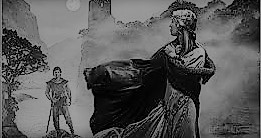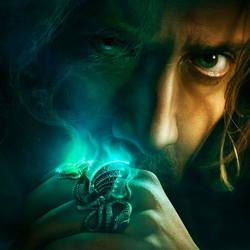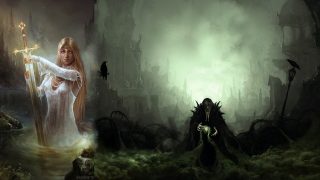Gli elementi naturali, che sia un fiume, una montagna, un lago e così via, sin dalla preistoria sono stati visti dall’uomo come “divinità”. L’uomo sottostava a tali divinità e ne provava un profondo rispetto (vedi ad esempio gli indiani d’America) rapportandosi quindi con la Natura stessa non come “padrone”, ma come “devoto servitore” delle singole entità che si manifestavano attraverso i vari elementi.
Ed è in virtù di tale rapporto dell’uomo con la Natura che nascono miti e leggende. Storie che narrano della nascita di un fiume, di un monte… o di un lago. Se poi quel lago ha la forma di un cuore… come ad esempio il lago di Scanno, stanne pur certo che ai posteri verrà tramandata una gran bella storia!

C’era una volta...
Le favole iniziano sempre così, ma ci sono anche racconti che sono a metà tra favola e leggenda, probabilmente le storie che circolano sul lago di Scanno, difficile capire se siano favole… o leggende. Favole perché le streghe, le fate, e tante altre strane creature che popolano l’immaginario collettivo dei bambini, “forse” nessuno le ha mai viste, anche se nei racconti c’è sempre il mago o la maga di turno e capaci di stupirci con “effetti speciali”. Leggende, poiché basate su personaggi realmente esistiti… come Pietro Barliario, un medico e alchimista salernitano realmente esistito nel XII sec. e noto al popolo abruzzese come il mago Bailardo, e Angiolina, una dama molto potente che viveva nel lago di Scanno, la cui figura viene riportata in un poema cavalleresco del 1400 in ottave, diffuso tra i pastori scannesi come “L’Antifor di Berosia” .
Esistono diverse leggende che narrano la storia del lago di Scanno. Secondo una di queste, Angiolina abitava in una rocca inaccessibile posta al centro del lago e si dedicava all’arte della magia per combattere Carlo Magno e i maghi a lei rivali. La sua figura, forse, è personificazione di un essere delle acque, che con il tempo ha assunto i connotati di una maga incantatrice.
Pietro Bailardo invece era noto alle cronache dell’epoca come un potente stregone. L’uomo, aveva fatto un patto con il diavolo, e in cambio aveva ricevuto un libro in cui erano riportate formule per ogni tipo di magia. Si racconta, che Bailardo riuscisse a far innamorare le donne più belle grazie a degli speciali filtri magici, riusciva inoltre a “trasformare” l’acqua in vino, e a far spuntare le corna sulla testa di chi gli era antipatico.
La figura di Angiolina e di Bailardo si intrecciano proprio sul lago di Scanno e secondo la leggenda Madama Angiolina, “La Dama di Scanno”, dopo averlo attratto a se con la sua magia, lo costrinse a rimanere sospeso tra il cielo e la terra. A riporlo definitivamente sulla terra fu il Diavolo stesso, chiamato in aiuto da Baialardo, una volta che questi ebbe recuperato il suo libro.
Secondo un’altra versione della leggenda, Madama Angiolina, viene riportata come una fata e eroina dei luoghi dove oggi sorge Scanno. Si racconta che Bailardo, mise gli occhi sulla donna e, deciso a tutti i costi ad ottenerla per soddisfare i suoi desideri, ordinò che questa venisse rapita. Angiolina, sapendo di essere in pericolo, fece nascere l’attuale lago sotto i piedi dei suoi rapinatori, lasciando che le acque li inghiottissero. Nonostante la nascita del lago, Bailardo, riuscì comunque a conquistare il regno della fata, facendo piovere mille bocche infuocate. Angiolina, riuscì però a salvarsi riparandosi sotto un grande ombrello realizzato grazie alla sua magia.
Secondo altre fonti, Madama Angiolina cadde morta a causa dell’ardente pioggia e, nel luogo dove morì, sorse il famoso lago di Scanno.
Rossella Tirimacco
MADAME ANGIOLINA, THE MAGICIAN BAILARDO AND “THE LEGEND OF LAKE SCANNO”
by Rossella Tirimacco
(Translated by Michael Mazzenga)
The natural elements, whether it is a river, a mountain, a lake and so on, have been seen by man as “divinity” since prehistoric times. Man was subjected to these deities and he felt a deep respect (see for example the American Indians), thus relating to nature itself not as “master,” but as “devoted servant” of the individual entities that manifested through the various elements.
And it is by virtue of this relationship between man and nature that myths and legends are born. Stories that narrate the birth of a river, a mountain… or a lake. If then that lake has the shape of a heart… as for example the lake of Scanno, be sure that a great history will be handed down to posterity!
“Once upon a time…”
The fairytales always start like that, but there are also stories that are halfway between fable and legend; probably the stories that circulate about Lake Scanno: it’s difficult to understand if they are fables… or legends. Fables because the witches, fairies, and many other strange creatures that populate the collective imagination of children, “perhaps” no one has ever seen, even if in the stories there is always the magician or sorceress on duty and able to amaze us with “special effects.” Legends, because they are based on really existent characters… like Pietro Barliario, a physician and alchemist from Salerno who actually existed in the twelfth century and was known to the people of Abruzzo as the magician Bailardo; and Angiolina, a very powerful lady who lived in Lake Scanno, whose figure is reported in a chivalric poem in octaves from 1400, widespread among the Scannesi shepherds as “The Antiphon of Berosia.”
There are several legends that tell the story of Lake Scanno. According to one of these, Angiolina lived in an inaccessible fortress located in the middle of the lake and dedicated herself to the art of magic to fight Charlemagne and the magicians who were her rivals. Her figure, perhaps, is the personification of a being of the waters, which over time has taken on the connotations of a magical enchantress.
Pietro Bailardo instead was known to the chronicles of the time as a powerful sorcerer. The man had made a pact with the Devil, and in return he had received a book containing formulas for every kind of magic. It is said that Bailardo could make people fall in love with the most beautiful women thanks to special magic philters; furthermore, he could “transform” water into wine, and make horns appear on the head of those who were unpleasant.
The figures of Angiolina and Bailardo intertwine right on Lake Scanno and according to the legend Madame Angiolina, “The Lady of Scanno,” after having attracted him with her magic, forced him to remain suspended between the sky and the earth. Putting him permanently on the earth was the Devil himself, called to help by Bailardo, once he had recovered his book.
According to another version of the legend, Madame Angiolina is reported as a fairy and heroine of the places where Scanno stands today. It is said that Bailardo set his sights on the woman and, determined at all costs to obtain her to satisfy his wishes, ordered that she be kidnapped. Angiolina, knowing she was in danger, gave birth to the current lake under the feet of his thieves, letting the waters swallow them. Despite the birth of the lake, Bailardo, however, managed to conquer the kingdom of the fairy, making it rain a thousand mouths of fire. Angiolina, however, managed to save herself by sheltering under a large umbrella made thanks to her magic.
According to other sources, Madame Angiolina fell dead because of the heavy rain, and in the place where she died rose the famous Lake Scanno.
Citazioni e fonti Il gioiello del tombolo




